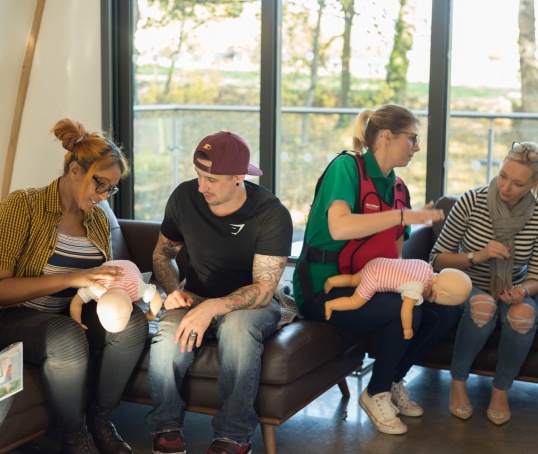Read our tips for gently encouraging your baby back to breastfeeding if they suddenly don’t want to feed.
What is a nursing strike?
A ‘nursing strike’ or ‘breastfeeding strike’ is when a baby who has been breastfeeding well refuses to feed. This isn’t the same as getting breastfeeding started with a new baby. For that, you could look at our articles on breastfeeding in the early days.
Although it’s common, when your baby refuses to breastfeed it can cause worry, distress and a feeling of rejection for the breastfeeding mothers and parents. Most nursing strikes are only temporary and babies usually return to breastfeeding well (La Leche League GB, 2017).
Reasons baby might be refusing the breast
There are lots of reasons that your baby might be refusing the breast. It can be because of physical changes the baby is experiencing, including:
- A blocked nose or earache
- A sore throat or mouth
- An illness like chicken pox
- Teething
- Reflux
- An infection, like thrush or a urinary tract infection
- Soreness from a vaccination
(La Leche League GB, 2017; Mohrbacher, 2013)
Or emotional reasons, including:
- Frustration at a low milk supply, or being overwhelmed by an oversupply of milk
- Being startled while feeding, for example by a loud noise or the parent expressing pain
(La Leche League GB, 2017)
The breastfeeding parent might unknowingly feel different to the baby, for example if:
- The parent is feeling stressed
- They smell different because they have changed their perfume or deodorant, or have been swimming
- The parent’s milk doesn’t taste the same. They might have been taking medicine or because of hormonal changes (like getting their period)
- The parent has changed breastfeeding patterns
- There has been a period of separation
(La Leche League GB, 2017; Australian Breastfeeding Association, 2022a)
And sometimes, we just don’t know why.
Tips to encourage your baby to feed
You can help your baby to get interested in feeding when they are refusing the breast by:
- Minimising distractions by sitting in a quiet room while feeding.
- If your baby appears to be ‘fighting’ the breast, you could try feeding in a ‘laid back’ position.
- Taking a bath together.
- Feeding them when they are sleepy.
- Putting a little breastmilk on their lips.
- Stimulating milk flow before feeding so your baby doesn’t have to work hard for the milk.
- Giving a small amount of the feed another way before finishing with the breast, so they’re not too hungry and upset to feed.
- Offering breastmilk ice lollies if your baby is teething or has a sore mouth, or frozen breastmilk cubes to suck through a clean muslin.
- Taking the pressure off by feeding them another way, but spending time cuddling them and giving them skin-to-skin contact.
- Give them pain relief first if they are in pain.
- Seeing your GP if you think your baby is unwell or hurt.
(Australian Breastfeeding Association, 2022b; Mohrbacher, 2013; La Leche League GB, 2017, Coulson, 2012)
Ensuring your baby is getting enough milk
There are ways you can tell if your baby is feeding enough.
When a breastfed baby is refusing the breast, you can make sure that they are getting enough milk another way.
- Express as often as your baby was feeding to maintain supply and avoid the breasts getting too full (engorged).
- Feed your baby the expressed milk.
- You could also offer some formula milk if your baby is under a year old, or cows milk if your baby is over 12 months.
(Mohrbacher, 2013; La Leche League GB, 2017)
How to support the mother or parent who is breastfeeding
You can support someone who is breastfeeding by:
- Creating an environment where they have the time and space to breastfeed, for example by taking care of them, other children or chores.
- Providing emotional support at what can be a distressing time.
(La Leche League GB, 2017)
Getting support
You can usually get same day support from an NCT Breastfeeding Counsellor. Our NCT infant feeding line is open every day for free support, from 8am to midnight. Call 0300 330 0700.
Talk to your midwife or health visitor who may be able to provide support if your baby is suddenly refusing the breast.
Always speak to a health professional if you are concerned about your baby.
Allow for grief
If your baby seems happy and healthy, is getting enough nutrition in other ways but continues to be no longer interested in breastfeeding, the breastfeeding parent might feel sad that it has ended earlier than they had wanted it to.
Allow yourself time to grieve at the sudden ending if it was earlier than you wanted it to be (La Leche League GB, 2017). Talking to an NCT Breastfeeding Counsellor might give you support and reassurance. Call our NCT infant feeding line on 0300 330 0700.
Further information
Our NCT infant feeding line offers practical and emotional support with feeding your baby and general enquiries for parents, members and volunteers: 0300 330 0700.
We also offer New Baby courses which are a great way for new parents to feel more confident.
Make friends with other parents-to-be and new parents in your local area and see what NCT activities are happening nearby.
Australian Breastfeeding Association (2022a) Why won’t my baby feed? https://www.breastfeeding.asn.au/resources/why-wont-baby-feed [31 Jul 24]
Australian Breastfeeding Association (2022b) Breast refusal – how to get baby to feed. https://www.breastfeeding.asn.au/resources/breast-refusal [31 Jul 24]
La Leche League GB (2017) Nursing strikes. https://laleche.org.uk/nursing-strikes/ [31 Jul 24]
Coulson S. (2012) Biological nurturing: the laid-back breastfeeding revolution. Midwifery Today, 101. https://midwiferytoday.com/mt-articles/biological-nurturing/ [31 Jul 24]
Mohrbacher N. (2013) Is your formerly nursing baby refusing to breastfeed? https://nancymohrbacher.com/blogs/news/is-your-formerly-nursing-baby-re… [31 Jul 24]







